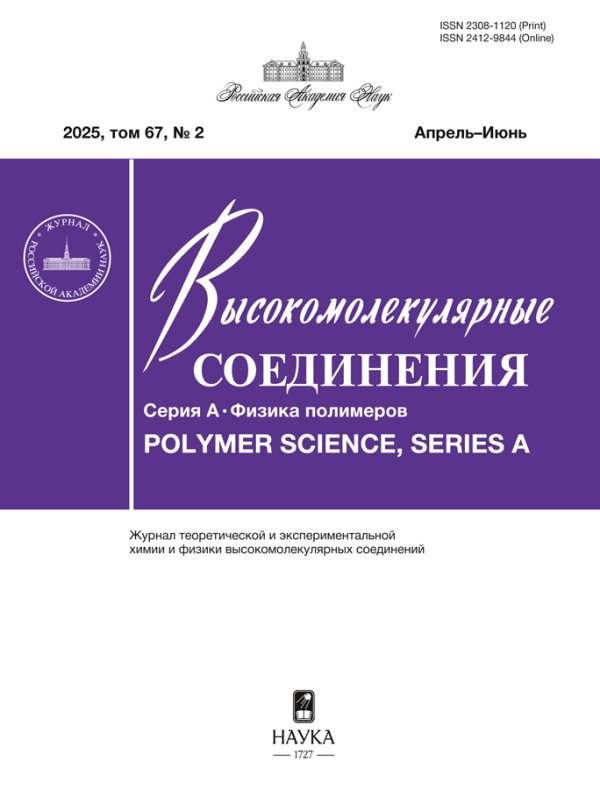Подвижность многократно протонированных полиэтиленоксидов в гелии при различных напряженностях электрического поля. Молекулярно-динамическое моделирование дрейфа ионов
- Authors: Дубровский С.А.1, Балабаев Н.К.1
-
Affiliations:
- Федеральный исследовательский центр химической физики им. Н.Н. Семенова Российской академии наук
- Issue: Vol 66, No 4 (2024)
- Pages: 291-303
- Section: ТЕОРИЯ И МОДЕЛИРОВАНИЕ
- URL: https://gynecology.orscience.ru/2308-1120/article/view/678312
- DOI: https://doi.org/10.31857/S2308112024040055
- EDN: https://elibrary.ru/MCJEVG
- ID: 678312
Cite item
Abstract
Дрейф многократно протонированных цепей полиэтиленоксида в гелии в электростатических полях различной напряженности моделируется методом молекулярной динамики. Результаты моделирования сравниваются с предсказаниями кинетической теории подвижности ионов, которая связывает эффект увеличения напряженности поля с ростом температуры иона. Как и следовало ожидать, внутренняя температура иона Tion повышается с увеличением кинетической энергии случайного движения, получаемой ионом от поля. Однако она растет медленнее, чем ожидается в двухтемпературной теории. Подвижность ионов рассчитывается как функция напряженности поля E при постоянной температуре газа T (300 К) и как функция T при низких E. Результаты этих двух серий расчетов сравниваются при одинаковых внутренних температурах ионов. Результаты совпадают при Tion, близкой к температуре газа. При высоких температурах иона они несколько расходятся (примерно на 8% при Tion = 600 К), что не согласуется с теорией. Конформации и размеры дрейфующих ионов, а также их сечения столкновения, рассчитанные по подвижности, свидетельствуют о том, что увеличение числа присоединенных протонов приводит к разворачиванию полимерной цепи. Этот эффект удовлетворительно согласуется с критерием Рэлея устойчивости заряженной капли. Увеличение напряженности поля влияет на сечение столкновения по нескольким причинам. Они включают в себя повышение температуры иона, приводящее к увеличению размера иона, уменьшение влияния дальнодействующих притягивающих взаимодействий и дипольную ориентацию, которая более выражена при меньшем количестве присоединенных протонов.
Full Text
About the authors
С. А. Дубровский
Федеральный исследовательский центр химической физики им. Н.Н. Семенова Российской академии наук
Author for correspondence.
Email: sd@chph.ras.ru
Russian Federation, 119991, Москва, ул. Косыгина, 4
Н. К. Балабаев
Федеральный исследовательский центр химической физики им. Н.Н. Семенова Российской академии наук
Email: sd@chph.ras.ru
Russian Federation, 119991, Москва, ул. Косыгина, 4
References
- Eiceman G.A., Karpas Z., Hill H.H. Ion Mobility Spectrometry. CRC Press, Boca Raton, Florida, 2014.
- Lapthorn C., Pullen F., Chowdhry B. Z. // Mass Spectrom. Rev. 2013. V. 32. P. 43.
- DuezQ., Hoyas S., Josse T., Cornil J., Gerbaux P., De Winter J. // Mass Spectrom. Rev. 2023. V. 42. P. 1129.
- Lanucara F., Holman S.W., Gray C.J., Eyers C.E. // Nature Chem. 2014. V. 6. P. 281.
- Karas M., Bachmann D., Bahr U., Hillenkamp F. // Int. J. Mass Spectrom. Ion Processes. 1987. V. 78. P. 53.
- Hillenkamp F., Peter-Katalinic J. MALDI MS: A Practical Guide to Instrumentation, Methods and Applications. Wiley-VCH, Weinheim, 2007.
- Fenn B., Mann M., Meng C.K., Wong S.F., Whitehouse C.M. // Science. 1989. V. 246. P. 64.
- Mason E.A., Schamp H.W. // Ann. Phys. 1958. V. 4. P. 233.
- Siems W.F., Viehland L.A., Hill H.H. // Analyst. 2016. V. 141. P. 6396.
- Shvartsburg A.A. Differential Ion Mobility Spectrometry. CRC Press, Boca Raton, Florida, 2009.
- D’Atri V., Porrini M., Rosu F., Gabelica V. // J. Mass Spectrom. 2015. V. 50. P. 711.
- Prell J.S. // Compr. Anal. Chem. 2019. V. 83. P. 1.
- Lai R., Dodds E. D., Li H. // J. Chem. Phys. 2018. V. 148. P. 064109.
- Dubrovskii S.A., Balabaev N.K. // Polym. Sci., Ser. A. 2022. V. 64. P. 549.
- Kaltashovand I.A., Abzalimov R.R. // J. Am. Soc. Mass Spectrom. 2008. V. 19. P. 1239.
- von Helden G., Wyttenbach T., Bowers M.T. // Int. J. Mass Spectrom. Ion Proc. 1995. V. 46/147. P. 349.
- Saucy D.A., Ude S., Lenggoro I.W., de la Mora J.F. // Anal. Chem. 2004. V. 76. P. 1045.
- Ude S., de la Mora J.F., Thomson B.A. // J. Am. Chem. Soc. 2004. V. 126. P. 12184.
- Trimpin S., Plasencia M., Isailovic D., Clemmer D.E. // Anal. Chem. 2007. V. 79. P. 7965.
- Larriba C., de la Mora J.F. // J. Phys. Chem. B. 2012. V. 116. P. 593.
- Consta S., Chung J.K. // J. Phys. Chem. B. 2011. V. 115. P. 10447.
- Viehland L.A., Fahey D.W. // J. Chem. Phys. 1983. V. 78. P. 435.
- Mason E.A., McDaniel E.W. Transport Properties of Ions in Gases. Wiley, New York, 1988.
- Kanev I.V., Balabaev N.K., Glyakina A.V., Morozov V.N. // J. Phys. Chem. B. 2012. V. 116. P. 5872.
- Balabaev N.K., Mazo M.A., Kramarenko E.Yu. // Macromolecules. 2017. V. 50. P. 432.
- Dubrovskii S.A., Balabaev N.K. // Polym. Sci., Ser. A. 2021. V. 63. P. 891.
- Dubrovskii S.A., Balabaev N.K. // Polym. Sci., Ser. A. 2023. V. 65. P. 213.
- Lemak A.S., Balabaev N.K. // Mol. Simul. 1995. V. 15. P. 223.
- Lemak A.S., Balabaev N.K. // J. Comput. Chem. 1996. V. 17. P. 1685.
- Hill J.R., Sauer J. // J. Phys. Chem. 1995. V. 99. P. 9536.
- Dubrovskii S.A., Balabaev N.K. // Polym. Sci., Ser. A. 2018. V. 60. P. 404.
- Dobrynin A.V., Rubinstein M. // Prog. Polym. Sci. 2005. V. 30. P. 1049.
- Lord Rayleigh // Philos. Mag. 1882. V. 14. P. 184.
- RubinsteinM., Colby R.H. Polymer Physics. Oxford University Press, Oxford, 2003.
- Polymer Handbook. / Eds. Brandrup J., Immergut E.H., Grulles E.A. V. 6. Wiley, New York, 1999. P. 526
- Bleiholder C., Johnson N.R., Contreras S., Wyttenbach T., Bowers M.T. // Anal. Chem. 2015. V. 87. P. 7196.
- Gandhi V.D., Larriba-Andaluz C. // Anal. Chim. Acta. 2021. V. 1184. P. 339019.
- Kulesza A., Marklund E.G., MacAleese L., Chirot F., Dugourd P. // J. Phys. Chem. B. 2018. V. 122. P. 8317.
- Shvartsburg A.A., Noskov S.Y., Purves R.W., Smith R.D. // Proc. Natl. Acad. Sci. 2009. V. 106. P. 6495.
Supplementary files


















